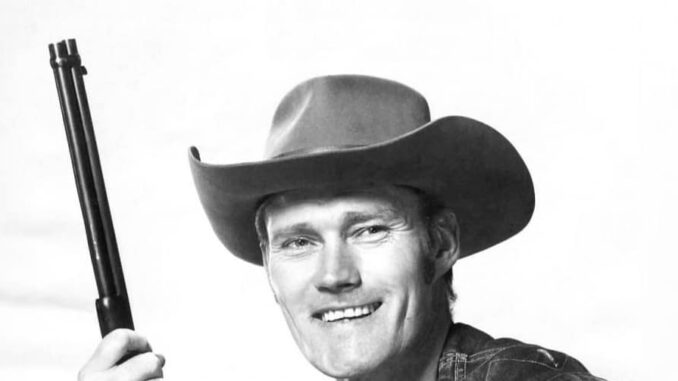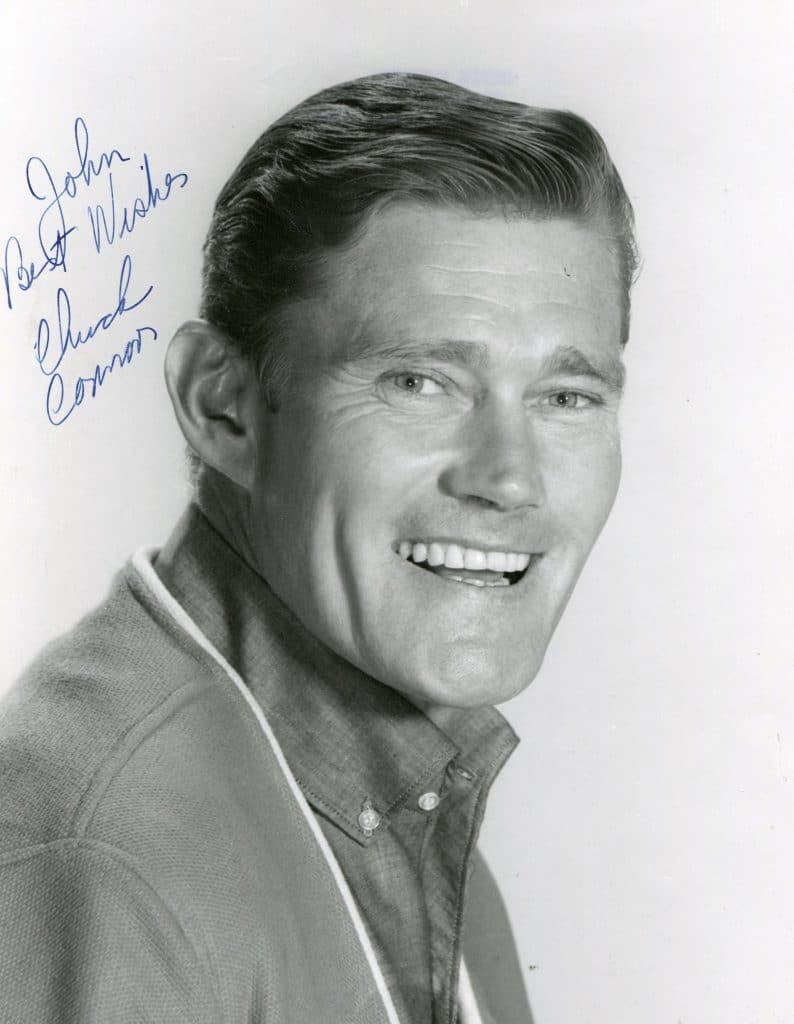
Chuck Connors was an American actor and professional baseball and basketball player, born on 10 April 1921 in Brooklyn, New York City USA. He’s known for his memorable role in the TV series “The Rifleman” and the movie “Old Yeller”.
Just a simple reminder that article is created and owned only by marriedbiography.org. Article cannot be re-published in any other pages or documents. Copyright is protected by DMCA. All found copies will be reported.
Original source: https://marriedbiography.org/the-untold-truth-of-chuck-connors-spouse-net-worth-wiki/
Early Life
Kevin Joseph Aloysius Connors was born the only son of Marcella and Alban Connors, Irish immigrants from Newfoundland and Labrador. The 1930’s Great Depression left his father unemployed for years, and his mother became the backbone of the family by working in office buildings scrubbing floors.
This resulted in Kevin and his younger sister Gloria growing-up facing the harshness of poverty. In his childhood and following his family’s Roman Catholic tradition, Connors became an altar boy in Sunset Park’s school Our Lady of Perpetual Help Basilica, which he also attended.
Chuck Connors, The Rifleman 1960s http://myvintagephotos.com/product_info.php?products_id=1223
Posted by MyVintagePhotos.com on Thursday, 10 April 2014
From childhood, Connors showed an amazing physical prowess and talent in various sports, a skill that gained him a spot to play in the local baseball team, Bay Ridge Celtics, and where he met coach John Flynn, who helped Connors to gain a scholarship to attend Adelphi Academy. Besides playing football and basketball during his high school years, Connors became a valuable asset for its baseball team. Allegedly he received numerous scholarship offers to attend various colleges.
However, he finally chose Seton Hall University in New Jersey, where he played in both the college’s basketball and baseball teams.
Change of Name
It’s rumored that Kevin changed his name during his college years because he disliked his first name “Kevin”.
Following a story told by his sister Nancy in 1997, Connors decided to adopt a name he thought suitable for him, trying with various nicknames such as “Lefty”, “Stretch” and finally “Chuck”, which originated from the custom phrase he would yell from his first base position to the pitcher ‘Chuck it to me, baby, chuck it to me!’.
However, other sources contradict this rumor and even Connors said something different in 1945: ‘They called me Chuck when I started playing baseball because they thought Kevin was effeminate’. Thus the year he officially started being known like this is undisclosed.
Career
Baseball – First Steps
Connors had been an avid fan of the now disappeared Brooklyn Dodgers since his childhood.
His dream of joining the team became a reality in 1940, when he signed a contract to play with them in a minor-league, leaving his studies aside in favor of baseball. However, his stay with the Dodgers was short-lived, as he was assigned to a Class-D League in Arkansas. In 1941 he signed with Norfolk Tars of Piedmont League, playing a total of 72 games with them during his one-year stay.
Army – 1942
On 20 October 1942 Connors left the league to enlist in US Army to serve his country during World War II. He was located at Fort Campbell in Kentucky as an instructor in tank-warfare, and was officially discharged in 1946.
Between Basketball and Baseball
After the war ended Chuck Connors went back to sports, though he didn’t return to baseball right away, and instead played in the National Basketball League’s (NBL) team Rochester Royals, participating in 14 games with them until his exit in March that year, going back to baseball to train with the New York Yankees.
After winning the National Baseball Minor League with a Yankees’ small team, Connors was transferred to the Brooklyn Dodgers and joined its farm club in Newport, Virginia. With this team he earned a good reputation as player, and became one of the prime prospects to form part of the main Dodgers team.
In the fall of 1946 Connors returned to his other career, joining the Basketball Association of America signing with the newly formed Boston Celtics. However, his role in the team wasn’t that promising: ‘I’m positive my greatest value to the Celtics was as an after-dinner speaker. It seems to me I did more public speaking for the team than playing that first season. They sent me all over New England on speaking engagements.’
Despite this, Connors would always been remembered as a legend of the National Basketball Association (NBA), for being the first player to shatter a backboard.

Baseball – Professional League
In 1947 Connors left basketball for good, after noticing that he was losing physical condition for baseball: ‘I had to leave the Celtics in late February for spring training, and figured I was in great shape because I had been running on the boards all winter. But because of that I found my legs actually were much tougher to get into condition. I think my baseball legs were bothered very much by basketball’.
Back with the Brooklyn Dodgers, Connors was sent to play in its Class-AA team Mobile, in Alabama, slowly ascending the league chain. This led him to be assigned to play in a top club in Montreal. Although his efforts were compensated by winning the International League, he wasn’t close to become a first baseman with the Dodgers. His playful and comedic nature helped him though, earning a good image with media that executives thought would be a positive for the team.
Thus this led him to become Dodger’s first base man in 1949.
During one of his first games with the team he was hit in his mouth by a ball, and taken to a hospital. This accident cost him two exhibitions games and a third one lost. Ultimately, Connors was put on the bench by the coach’s decision.
Shortly after this event executives took the decision to transfer Connors to the farm team Los Angeles Angels, which resulted in his favor, as in California, he met various producers, directors and other people in the entertainment industry.
Acting
During his time playing with the Angels, Connors received a call from director Bill Grady to be tested for a small role in “Pat and Mike”. This served Connors well, as he felt that he’d found his next career: ‘I said right then, this is my racket.
Playing with Tracy and Hepburn, I was in the big leagues much faster than I arrived there in baseball’.
Although he continued playing baseball, his acting appearances continued to increase, and by 1952 he had roles in various movies which provided him with a better income than his career in sports. In 1953 he officially left baseball, though he was always grateful for what it gave him: ‘Baseball owes me nothing. I owe it all that I have and much of what I hope to have. Baseball made my entrance to the film industry immeasurably easier than I could have made it alone. To the greatest game in the world I shall be eternally in debt’.
In his acting career, Connors appeared in several movies, including “Move Over Darling”, “Soylent Green” and “Flipper”. He also became a recurrent TV actor, with roles in series such as “Dear Phoebe”, “Hey, Jeannie!” and “Here’s Lucy”.
However, there were two roles that cemented his career in Hollywood. First he appeared as Burn Sanderson in the Disney adventure movie “Old Yeller” in 1958. With this character he won viewers’ hearts, and led him to be cast in the starring role of “The Rifleman” as Lucas McCain. The western series ran for five years from 1958 to 1963, and would be the most widely recognized acting work of his career.
Personal Life
Romantic Life
Connors married for the first time in 1948 to Elizabeth Riddel, who he met at a baseball game. The couple had four sons together named Michael, Jeffrey, Stephen and Kevin, but ultimately filed for divorce in 1961.
In 1963 Connors married Kamala Devi, his co-star in “Geronimo”. The couple didn’t have any children, and divorced in 1973.
In 1973 Connors met actress Faith Quabius during the film of “Soylent Green” and they married four years later. However, the union was short lived, and they filed for divorce in 1979.
Connors’ last publicly known romantic relationship was with Rose Mary Grumley, who was with him until he died.
Death
On 10 November 1992 Connors died in a Los Angeles’ medical center as a result of complications related to lung cancer, an illness resulting from his decades-long habit of smoking, although he gave it up in 1972.
Net Worth
Chuck Connors had an estimated net worth of $5 millions, a result of his career as actor, and as a professional basketball and baseball player.
“The Rifleman,” starring Chuck Connors aired its last original episode on this date in 1963. The ABC series ran for five…
Posted by Classic Hollywood | Los Angeles Times on Friday, 8 April 2016
Physical Appearance
Chuck Connors was a man of American ethnicity. His impressive stature and defined facial features gave him a tough looking appearance. He was 6ft 6ins (1.98) tall, though his weight is unknown. His hair was dark-brown and his eyes blue.
Interesting Facts
He was interested in charity, and founded his own organization Chuck Connors Charitable Foundation.
Connors was a Republican Party supporter, developing a close friendship with Richard Nixon, and campaigning for Ronald Reagan a former colleague in the acting profession.
Connors met Soviet Union’s leader Leonid Brezhnev in 1973, and gifted him two Colt six-guns.
His father obtained his American citizenship in 1914 and his mother in 1930.
Leave a Reply